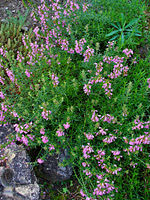Hyssopus officinalis
| Hyssop | |
|---|---|

| |
| 1885 illustration[1] | |
| Scientific classification | |
| Kingdom: | |
| (unranked): | |
| (unranked): | |
| (unranked): | |
| Order: | |
| Family: | |
| Subfamily: | |
| Tribe: | |
| Genus: | |
| Species: | H. officinalis
|
| Binomial name | |
| Hyssopus officinalis | |
| Synonyms[2] | |
| |

Hyssopus officinalis or hyssop is a(n) herbaceous plant of the genus Hyssopus native to Southern Europe, the Middle East, and the region surrounding the Caspian Sea. Due to its properties as an antiseptic, cough reliever, and expectorant, it is commonly used as a medicinal plant.
Characteristics
Hyssop is a brightly coloured shrub or subshrub that ranges from 30 to 60 cm (12 to 24 in) in height. The stem is woody at the base, from which grow a number of straight branches. Its leaves are lanceolate, dark green in colour, and from 2 to 2.5 cm (0.79 to 0.98 in) long.[3]
During the summer, the plant produces bunches of pink, blue, or, more rarely, white fragrant flowers. These give rise to small oblong achenes.
History
A plant called hyssop has been in use since classical antiquity. Its name is a direct adaptation from the Greek ὕσσωπος. The Hebrew word אזוב (ezov, esov, or esob) and the Greek word ὕσσωπος probably share a common (unknown) origin.[4] The name hyssop appears as a translation of ezov in some translations of the Bible, notably in verse 7 of Psalm 51: "Thou shalt purge me with hyssop, and I shall be clean" (King James Bible), but researchers have suggested that the Biblical accounts refer not to the plant currently known as hyssop but rather to one of a number of different herbs, including Origanum syriacum (Syrian oregano, commonly referred to as "bible hyssop").[5][6][7]
Hyssop was also used for purgation (religious purification) in Egypt, where, according to Chaeremon the Stoic, the priests used to eat it with bread in order to purify this type of food and make it suitable for their austere diet.[8]
Cultivation
The species as a whole is resistant to drought, and tolerant of chalky, sandy soils. It thrives in full sun and warm climates.
Cultivars include 'Blue Flower'.
Harvest
Under optimal weather conditions, herb hyssop is harvested twice yearly, once at the end of spring and once more at the beginning of the fall. The plants are preferably harvested when flowering in order to collect the flowering tips.
Once the stalks are cut, they are collected and dried either stacked on pallets to allow for draining or hung to dry. The actual drying process takes place in a cool, dry, well-ventilated area, where the materials are mixed several times to ensure even drying. Drying herbs are kept from exposure to the sun to prevent discoloration and oxidation. The drying process takes approximately six days in its entirety. Once dried, the leaves are removed and both components, leaves and flowers, are chopped finely. The final dried product weighs a third of the initial fresh weight and can be stored for up to 18 months.
Uses
The fresh herb is commonly used in cooking. Essence of hyssop can be obtained by steaming, and is used in cooking to a lesser extent.
The plant is commonly used by beekeepers to produce a rich and aromatic honey.
Herb hyssop leaves are used as an aromatic condiment. The leaves have a lightly bitter taste due to its tannins, and an intense minty aroma. Due to its intensity, it is used moderately in cooking. The herb is also used to flavor liqueur, and is part of the official formulation of Chartreuse.
Medicinal uses

As a medicinal herb, hyssop has soothing, expectorant, and cough suppressant properties.[9][unreliable medical source?] The plant also includes the chemicals thujone and phenol, which give it antiseptic properties.[10] Its high concentrations of thujone and chemicals that stimulate the central nervous system can provoke epileptic reactions when taken in high enough doses. The oil of hyssop can cause seizures and even low doses (2–3 drops) can cause convulsions in children.[11]
It has been also used in the formulation of eye drops and mouthwash.
Herb hyssop has also been observed to stimulate the gastrointestinal system.[12]
References
- ^ Prof. Dr. Otto Wilhelm Thomé, Flora von Deutschland, Österreich und der Schweiz 1885, Gera, Germany
- ^ "The Plant List: A Working List of All Plant Species". Retrieved 13 January 2015.
- ^ Pérez Maté, P. (2002). Especies aromáticas y medicinales (in Spanish). Buenos Aires: INTA. [1].
- ^ Oxford English Dictionary, 2nd Edition, 1989, s.v. hyssop
- ^ Fleisher, A.; Fleisher, Z. (1988). "Identification of biblical hyssop and origin of the traditional use of oregano-group herbs in the Mediterranean region". Economic Botany. 42 (2): 232–241. doi:10.1007/bf02858924.
{{cite journal}}: CS1 maint: multiple names: authors list (link) - ^ R.K. Harrison (1954). "The Biblical Problem of Hyssop" (PDF). The Evangelical Quarterly. 26 (4): 218–224.
- ^ http://pfaf.org/user/Plant.aspx?LatinName=Origanum+syriacum
- ^ From Chaeremon's History of Egypt, as quoted by Porphyry, De Abstinentia IV.6.9.
- ^ Grieve, M. "Hyssop: A Modern Herbal". Botanical.com.
- ^ van Wyk, Ben-Erik; Wink, Michael (2004). Medicinal Plants of the World (1 ed.). Timber Press, Incorporated. ISBN 978-0-88192-602-6., p 177.
- ^ Hyssop, WebMD
- ^ Crellin, John; Philpott, Jane (1997). A Reference Guide to Medicinal Plants: Herbal Medicine Past and Present. Duke University Press. ISBN 978-0-8223-1019-8.
External links
 Media related to Hyssopus officinalis at Wikimedia Commons
Media related to Hyssopus officinalis at Wikimedia Commons Data related to Hyssopus officinalis at Wikispecies
Data related to Hyssopus officinalis at Wikispecies- "Herb to Know: Hyssop"—The Herb Companion
